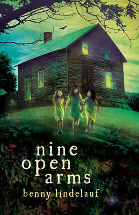Nine open arms by Benny Lindelauf

Allen & Unwin, 2014. ISBN 9781743315859.
Fing and her siblings have a father who dreams incessantly but fails
miserably in every enterprise he undertakes. Perpetually struggling
to make ends meet, this austere Dutch family constantly has to move
home and their arrival at a strangely positioned, poorly maintained
house opens the narrative.
The children's Grandmother assumed the maternal role on the passing
of the mother and when occasion dictates, she tells a family tale,
accompanied by photographs from her special crocodile skin bag.
Stories within stories are a feature of this quirky novel and the
reader is soon captivated, wanting to understand the family's
history and that of connected village characters from previous
generations.
Being a translation, language and cultural features give this novel
a very different feel, yet this improves rather than hinders the
story which reveals the fears, difficulties and pain felt by family
members, as well as the shared love, protection and support.
Cleverly intertwined with the depiction of this family's present
circumstances and revelations about its past is the little known
story of Nienevee, a Romany traveller and Charlie, a furniture maker
in the town. In spite of brutal intolerance to the travelling folk
displayed by the town's inhabitants, the pair slowly develop a
romance over many years and this contributes a significant element
to the plot development.
Boldly drawn characters appear in this tale and they ring true,
showing kindness, tolerance and understanding towards the fragile
members of the family and wider community whilst demonstrating
perfectly normal human frailties at other times. When delicate
individuals respond unexpectedly, one can't stop reading to learn
how this micro community fares. This story celebrates its quirky
differences and at times tears the heart before making it brim with
warmth. Complex consideration of what constitutes "home" and
associated notions of security, belonging and memory are presented.
The opening explains that the year is 1937 and the location is on
the border with Germany. Interestingly, whilst this promotes a sense
of foreboding, it does not feature at all in the story. What it does
however is leave the reader ruminating upon the welfare of the
family following the invasion.
Rob Welsh